|
 Phaeocollybia minuta Phaeocollybia minuta
BiostatusPresent in region - Indigenous. Endemic
Images (click to enlarge)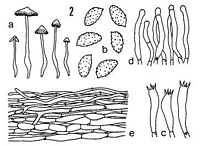
Caption: Phaeocollybia minuta Hk. (type):
a. carpophores. b. spores. c. basidia.
d. cheilocystidia. e. cuticle | 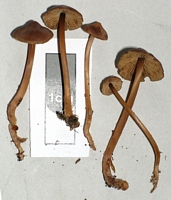
Owner: J.A. Cooper | 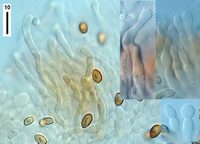
Caption: cheilocystidia
Owner: J.A. Cooper | 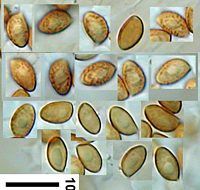
Caption: spores
Owner: J.A. Cooper | 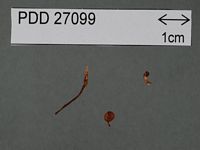
Caption: Dried type specimen
Owner: Herb PDD |
Article: Horak, E. (1973). Fungi Agaricini Novazelandiae I-V. Beihefte zur Nova Hedwigia 43: 200 p.
Description: Pileus 4-12 mm broad, conic when young becoming
conico-convex then campanulate with distinct obtuse umbo, date brown to yellow-brown
or honey brown, dry, glabrous to minutely fibrillose, striated towards the margin.
Lamellae adnexed to free, whitish or yellowish when young turning brownish-yellow
with rust brown tinge, crowded, gill edge concolorous, even. Stipe 15-35 x 1-2(3)
mm, fusoid, rooting, pseudorhiza absent, concolorous with pileus or paler, often
whitish at the base, dry, glabrous, tough, hollow, single. Context dark brown,
not gelatinous. Odor and taste distinctly raphanoid. Chemical reactions on pileus:
KOH, HC1 and NH3 - negative.
Spores
6-7 x 3.5-4 µm, subamygdaliform to ellipsoid, rugulose-roughened, without distinct
mucro, ferruginous. Basidia 20-27 x 5 µm, 4-spored. Cheilocystidia 20-30 x 2-3
µm, hair-like with rounded apex, hyaline, membrane thin-walled, scattered on
gill edge. Pleurocystidia absent. Cuticle a cutis consisting of repent, cylindric,
thin-walled, not gelatinized hyphae (2-8 µm diam.), encrusted with brown pigment.
Clamp connections numerous on cuticular hyphae.
Habitat: On
soil amongst mosses in Nothofagus forests (N. menziesii, N. cliffortioides)
with Dacrydium cupressinum. New Zealand.
Notes: From
the microscopic point of view (spores, cheilocystidia) this species resembles
Ph. yenniae (Karsten) (= Ph. cidaris [Fr.] ss. Kuhner & Romagnesi
1957: 48; ss. Moser 1967) but the habit of the N.Z. fungus is much more delicate
and its stipe is fusoid rather than gradually tapering towards the base.
Ph. minuta Hk. represents
by far the smallest member presently known in the genus Phaeocollybia.
The pileus does not exceed 15 mm in diameter. Another outstanding character
of this taxon are the clamp connections which occur on all septae of the cuticular
hyphae. Except for Ph. radicata (Murrill) Singer and Ph. amazonica
Singer clamp connections are absent in all other species of Phaeocollybia.
|